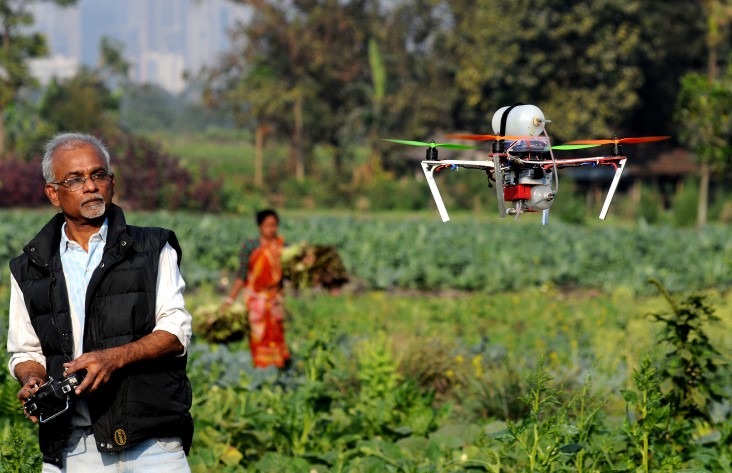- What We Do
- Agriculture and Food Security
- Democracy, Human Rights and Governance
- Economic Growth and Trade
- Education
- Environment and Global Climate Change
- Gender Equality and Women's Empowerment
- Global Health
- Humanitarian Assistance
- Transformation at USAID
- Water and Sanitation
- Working in Crises and Conflict
- U.S. Global Development Lab
Speeches Shim

The U.S. Global Development Lab (Lab) and the Bureau for Food Security collaborated in an effort called “Digital Development for Feed the Future” (D2FTF) to demonstrate how leveraging digital tools holistically and according to best practices can improve the cost effectiveness and development results of the U.S. Government’s Feed the Future Initiative.
Digital Development for Feed the Future is focused on four categories of digital tools, based on evidence on their impact: (1) precision agriculture (including sensor technology), (2) digital financial services, (3) data-driven agriculture, and (4) ICT-enabled extension. Digital Development for Feed the Future is scaling the use of these tools through various methods of engagement including: technical assistance to Feed the Future programs, capacity building for Feed the Future teams, and through strengthening the knowledge base on best practices.
Case Studies
D2FTF worked on a series case studies highlighting how organizations within Feed the Future zones of influence, and across the agriculture sector globally, are using digital tools and technologies to more efficiently and effectively meet their goals, while also documenting improved agricultural outcomes as a result. Each case study in this series looks at different approaches to adoption and how the tools are impacting organizational culture, operations, and programming.
- One Acre Fund Case Study One Acre Fund began with a pilot in western Kenya to increase the profits farm families earned from their fields by providing them with financing for high-quality agricultural inputs and nonagricultural products. Digital tools reduce barriers and distance to markets, lower transaction costs, improve feedback and communication among actors, and enhance yields. This case study tells the story of how digital tools are enabling OAF to accelerate achievement of its goals
- Naatal Mbay Case Study A four year Feed the Future Senegal Project with the goal of scaling up and expanding successful value chain approaches by introducing digital tools to enable value chain actors to leverage the power of data to better serve farmers. A basic set of digital technologies, mainly laptops loaded with Microsoft Office, enable value chain actors to leverage the power of data to better serve farmers, monitor activities, increase transparency along the chain, and attract investment.
- Musoni Case Study Established in 2010, Musoni became the first completely cashless microfinance institution in the world, by enabling customers to receive and repay their loans via Safaricom’s M-PESA system, rather than in cash. "Kilimo Booster", a loan product designed by Musoni, provides farmer loans with flexible terms & grace period based on seasonal cash flow.
- ADVANCE II Case Study Building on pilots initiated under ADVANCE I, its predecessor program, ADVANCE II has integrated a full suite of digital tools into its programming. In doing so, the project aims to increase the earnings and security of the smallholder farmers it supports throughout Ghana.
- ICRISAT Case Study This case study describes the digital agriculture work led by the International Crops Research Center for the Semi-Arid Tropics (ICRISAT), a CGIAR center based in Hyderabad, India.
- CIAT Case Study This case study describes the data-driven agronomy work led by the International Center for Tropical Agriculture (CIAT), a CGIAR center headquartered in Cali, Colombia.
If you know of an organization that would be a good candidate for a case study, click here to fill out a short survey to be considered.
Resources and Tools for Digital Agriculture
Digital Development for Feed the Future has also worked to compile a comprehensive list of resources for both USAID, implementor, and private sector partners to utlize in their programming and execution of agriculture programs.
Data Driven Agriculture Paper This is a landscape asessment paper examining how smallholder farmers are profiled, how their needs are understood and met, how the impact of agricultural services is measured, how farmer data is shared, and how a global body of knowledge can be built by drawing on typically siloed expertise and data.
Farmer Profile Infographic A digital farmer profile is a profile that can capture comprehensive data on a farmer and their farm. Full farmer profile report coming in May, 2018.
Using Digital Tools to Expand Access to Agricultural Insurance this guide aims to help USAID and its development partners effectively leverage these new tools to expand access to and use of agricultural insurance.
Digital Financial Services in Agriculture Guide helps identify specific challenges in value chains, and to subsequently identify corresponding digital financial service (DFS) solutions with the aim of advancing digital financial inclusion for smallholder farmers.
How Digital Tools Impact the Value Chain this document is the result of a meta analysis of 200 documents and reports with evidence demonstrating the value of integrating digital tools into agriculture.
Toolkit: Digital Tools in Agriculture Programming this toolkit is a comprehensive compliation of all ways USAID implementers and partners can implement digital tools across their agriculture programs.
Digital Tools for Agriculture Fact Sheet learn more about the digital agriculture team housed in the U.S. Global Development Lab in the Center for Digital Development.
Using Digital Tools to Grow Agriculture and Financial Inclusion in Ethiopia learn how USAID and Feed the Future are working to increase financial inclusion in Ethiopia.

Comment
Make a general inquiry or suggest an improvement.